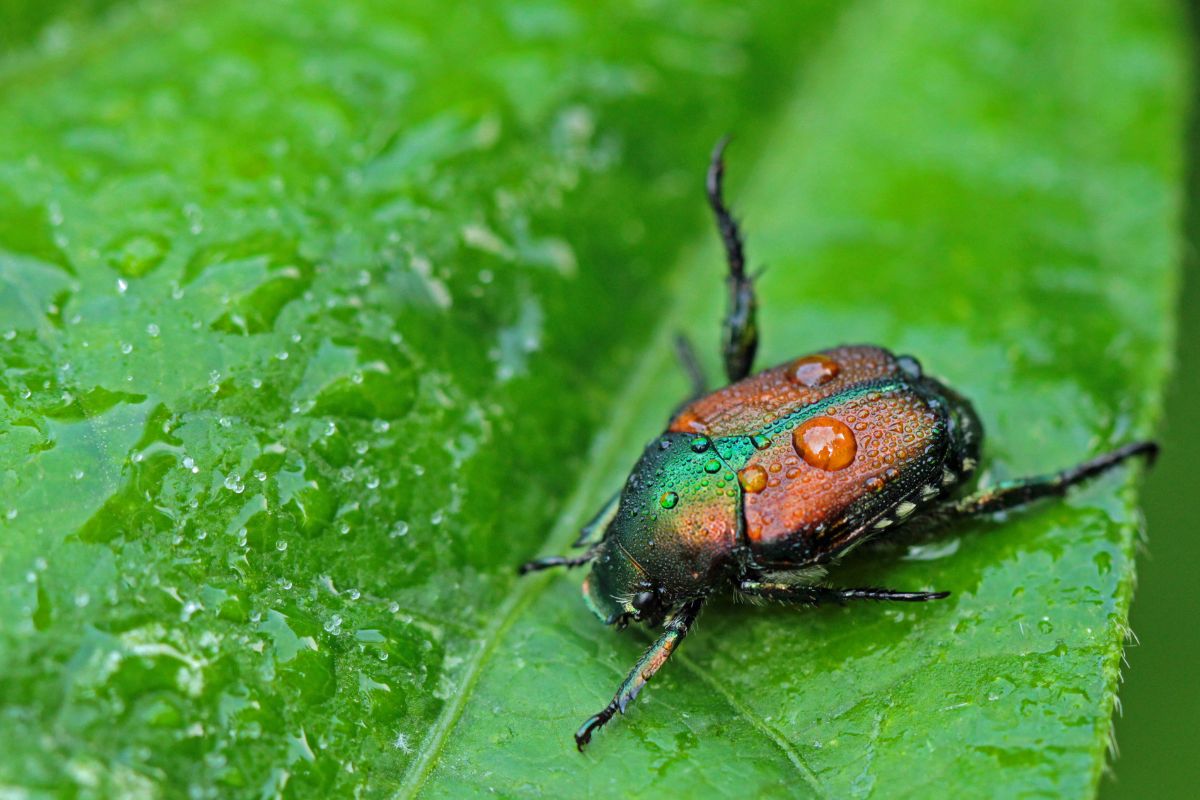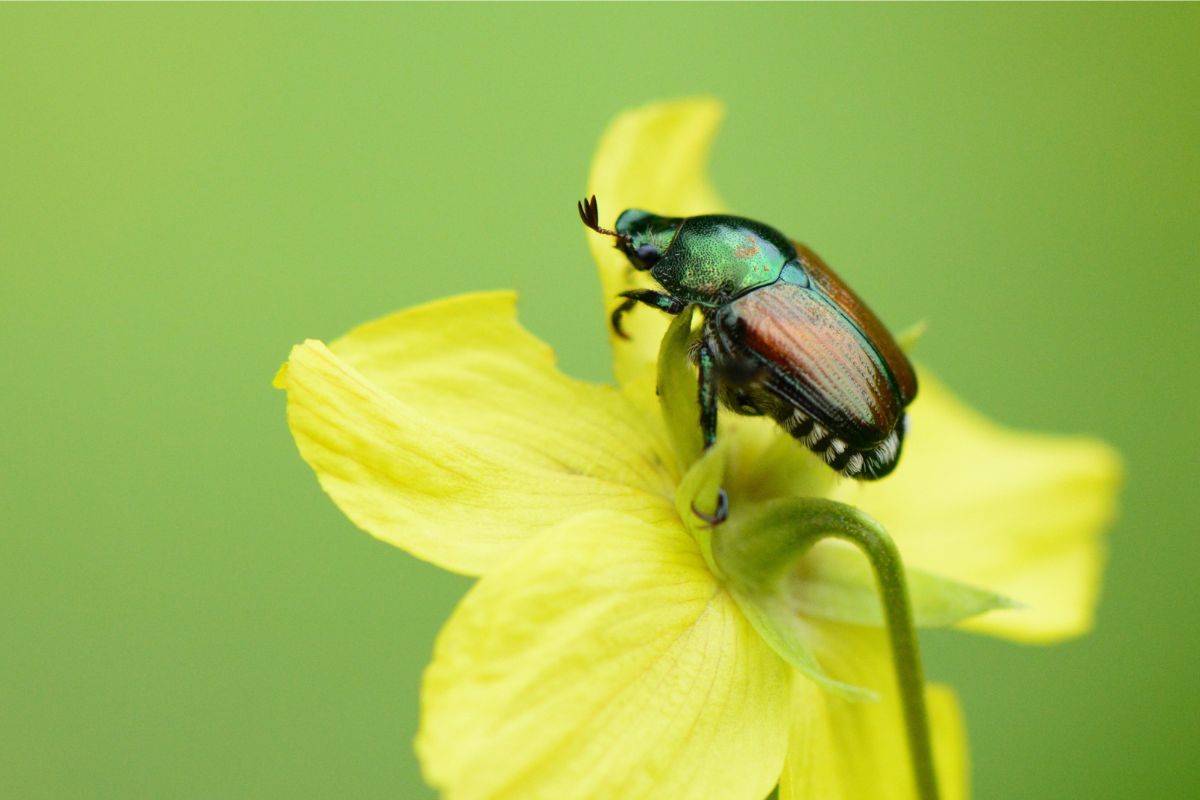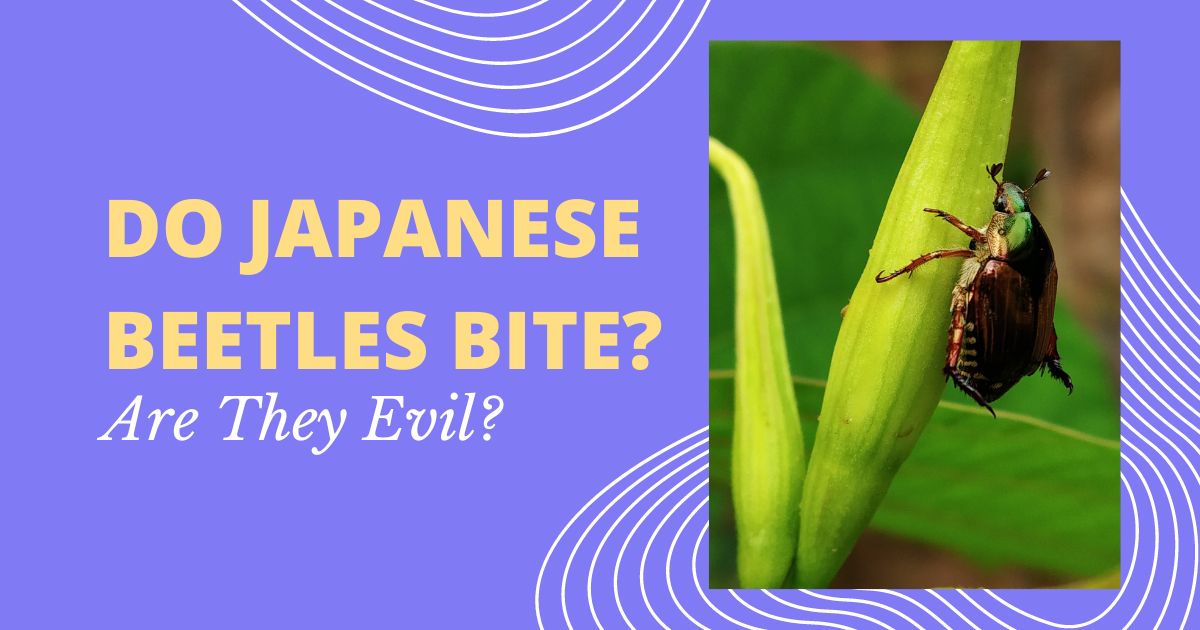If you are reading this, you probably wonder, “Do Japanese beetles bite?” The answer may surprise you. Many people think Japanese beetles are a type of mosquito, but they are a beetle species.
If you are looking into studying Japanese beetles, you have a lot to learn. Like any living thing, they belong to the animal kingdom, class Insecta, and order Coleoptera.
This guide will help you know more about Japanese beetles and answer various questions you are likely to ask yourself, e.g., What does a Japanese beetle look like? Why is the Japanese beetle harmful? Do Japanese beetles fly? How to kill Japanese beetle grubs?
Ready to get started? Let’s begin!

What are Japanese Beetles?
There are over 400,000 described species of beetles. As their name suggests, Japanese beetles (Popillia Japonica) are native to Japan. Japanese beetles are harmful to both humans and plants.
Japanese beetles have iridescent green and copper coloration, making them appear like dazzling insects. The brilliantly colored beetles emerge from the ground after beginning their lives as white grubs before wreaking devastation on garden plants.
Do Japanese Beetles Bite?
Do Japanese beetles bite or sting? Are they considered harmless to humans? It is sporadic for you to come across a Japanese beetle that bites.
They have strong mandibles, though, which they utilize to chew plants. Their fangs are not strong enough to pierce human skin. The legs of Japanese beetles include sharp spines that could itch your skin.
What Does a Japanese Beetle Look Like?
It is mythical to think that all beetles are black in color. They do come in different shapes and sizes. Fortunately for us, Japanese beetles possess outstanding features that make it easy to differentiate them from others.
When young (larvae) Japanese beetles look like caterpillars, they are white with a long elongated body. Adult Japanese beetles are half an inch in length with metallic blue-green heads.
They have copper-colored backs, tan wings, and tiny white hairs lining each side of the abdomen. They have six legs with spine-like structures, two antennas, and wings.
One noticeable feature of Japanese beetles is that they have two compound eyes, which gives them a 360° panoramic view of their surroundings.
When Do Japanese Beetles Come Out?
When are Japanese beetles most active? The period from late June through August or September is when they are most active. Adult beetles tend to feed on plants early in the morning and late in the afternoon.
Japanese beetles live up to two months during their adult life; afterward, they die due to temperature and climate variations.
How to Get Rid of Japanese Beetles
One would ask why to get rid of such insects. It might be the fact that they don’t discriminate when it comes to the type of plants they feed on. Well, here are some ideas on how to get rid of them:
Hand Pick
Japanese beetles are easy to see and relatively easy to knock into a can of soapy water.
It is time-consuming but the most effective way to get rid of them.
Dropcloth
Put down a dropcloth early in the morning when beetles are most active, shake them off, and dump them in a bucket of soapy water.
Neem Oil
Neem oil is sprayed on the plants to do this. Adult beetles ingest a chemical in neem oil which they pass it on in their eggs; the larvae die before they become adults.
Japanese Beetle Traps
Pheromone traps tend to control large numbers of beetles.
Some traps attract beetles a little bit too well; placing the trap far from your garden may pull beetles from all over.
Fruit Cocktail Trap
We all love sweet smells; beetles are no exception to this. A fruit Cocktail is the most natural and effective method on how to get rid of Japanese beetles.
Ferment fruit cocktails for about a week, place them on top of wood blocks in a light-colored pail; fill the bucket with water to just below the top, and put the can at about 25 feet (7.62 meters) from the plants you want to protect.
Parasitic Nematodes
Japanese beetles lay eggs in the soil. When the larvae hatch, they grow into a caterpillar-like insect known as a grub. Parasitic nematodes can be introduced as they will feed on them.
Insecticides
Spraying or dusting the places where you want to get rid of beetles will accomplish this. Beetles often die as a result of the harmful chemical reactions.
You can control adult Japanese beetles by the use of various chemicals; permethrin, deltamethrin, carbaryl, and bifenthrin. For grubs, imidacloprid and halofenozide trichlorfon chlorantraniliprole.
It is vital to note that even when used properly, insecticides can pose severe hazards to people, wildlife, and the environment at large.
Repel Beetles
For other Japanese beetles, the smell of deceased ones serves as a deterrent. Let traps or containers filled with dead beetles (the ones you hand-pick or catch) sit close to desirable plants.
Predators
In your garden, birds are probably the most straightforward to attract. If you offer food, shelter, and water, birds will congregate in your yard. Some birds eat beetles, e.g., catbirds, cardinals, and robins.
Crows and starlings are among those who favor the grubs. In the fall, starling flocks are likely digging up grubs as they fly through your yard. Tachinid flies appear when the number of beetles is large. Adult Japanese beetle heads are where they lay their eggs.
When the eggs hatch, the larvae enter the beetle to feed and live, killing the beetle in the process. Adult tachinid flies consume nectar, just like many useful insects. Dill, fennel, sweet clover, gomphrena, and mint are among their favorite flowers.

Do Japanese Beetles Fly?
Beetles do fly; their flight is, however, aimless except in response to chemical stimuli of food plants or sex pheromones. Temperatures about 21 degrees Celsius (68.9 Fahrenheit) tend to be the most suitable for moving about.
Most flights are short distances, but the beetle can fly up to 8 kilometers(4.9 miles) with the wind.
Why is a Japanese Beetle Harmful?
To human beings, Japanese beetles are not dangerous; they contribute to food shortages if left unchecked. They are a very harmful plant pest that can be expensive and difficult to eradicate.
Feeding on grassroots, Japanese beetle grubs damage lawns and pastures. Adult Japanese beetles attack the foliage, flowers, and fruits of more than 300 different ornamental and agricultural plants.
How to Kill Japanese Beetle Grubs
It is advisable to solve a problem before it gets out of hand. Young grubs are more susceptible to various approaches, whereas mature larvae are more resistant.
The best time to control grubs is from mid-July to late September.
One may opt to use insecticides, but there is a much straightforward approach . It is simple and more affordable; you only need to spray the surface with two tablespoons of liquid dishwashing soap. The grubs will surface, and the birds will love you for providing a meal.
How to Treat Japanese Beetle Bites
Japanese beetles don’t bite too often because they don’t come in direct contact with humans or other animals very much. They are herbivores and seek out flowers and leaves to feed on. They stay away from animals who could be considered threats.
These beetles are considered harmless to humans. While they may gnaw away at plants and flowers, you will not see a Japanese beetle bite on your skin. There is no evidence to suggest that these beetles bite.
They do, however, have rough spines on their legs that might feel prickly against your skin. Most of the time, it is mistaken for a bite. In cases of sensitive skin, one may develop rashes, but it is nothing to worry about.
Applying oil or cold water to the affected area will make the itch subside.
Interesting Facts About Japanese Beetles
The introduction of Japanese beetles in North America and Europe was accidental. Irish bulbs sent from Japan containing Japanese beetles are their dissemination agent.
These insects are still invading other areas by hitching rides, freight, and even air cargo, whereas grubs and eggs travel in soil used for gardening. They are, however, not considered significant pests because of the natural predators that eat them.
Japanese beetles like the sun. Adults prefer to feed and mate on warm sunny days. They are also attracted to roses.
When you approach Japanese beetles, they lift their hind legs to scare off predators. All kinds of beetles chew their meal before swallowing, just like humans do. All beetle larvae and adult beetles have this characteristic.
What Do Japanese Beetles Eat?
Flowers are beautiful with pleasant scents. For adult Japanese beetles, this is different. They feed on flowers, foliage, or fruits of over 300 plant species.
Their favorite plants include:
- Roses
- Grapes
- Hibiscus
- Raspberries
These beetles start at the top of the plant, working their way down, eating everything.
When adults consume the entire upper half of a leaf, they leave the veins and midribs behind, giving the appearance of a skeletonized plant. Larvae use the soil’s decomposing material as food. They also feed on various types of roots such as grassroots, shrubs roots, and cereal grain roots.
The Japanese Beetle Life Cycle
The complete metamorphosis, or four developmental stages, of the Japanese beetle is its life cycle. Egg, larval, pupa, and adult are the different life stages.
Japanese beetles live only 30 to 45 days on average as adults. As they eat, they mate on the food plants. Later, the female beetles locate a location to lay their eggs.
The female beetle lays 1 to 5 eggs during each egg-laying session, burying them beneath 2 to 4 inches of soil.
The females’ jobs are to feed, mate, and lay eggs. Every 24 to 48 hours, they repeat this process until they have laid 40 eggs throughout their entire life cycle.
The eggs take around ten months to mature into grubs, which are larvae.
FAQs
Can You Spot a Japanese Beetle With Your Naked Eye?
Many types of beetles come in various colors and shapes. For Japanese beetles, look for white tufts of hair along the edge of the body underneath the wings.
Can You Pick up a Japanese Beetle?
The insects move slowly and don’t bite or pinch. Wearing thin gardening gloves, if you prefer, can help you examine Japanese beetles.
Does Squishing Japanese Beetles Attract More?
They release a pheromone when crushed, attracting other beetles. According to research, crushing does not attract more feeders. It is true that the application of pheromones can attract Japanese beetles to a certain place. The smell acts as bait in Japanese beetles to lure the adults.

The Bottom Line
It is now evident to conclude that Japanese beetles do not cause serious harm to human skin. They, however, have adverse effects on vegetation.
It is fun to learn and discover new things, especially about animals. I believe you are now more enlightened about Japanese beetles. Did you find this information helpful? Please leave a comment below.
